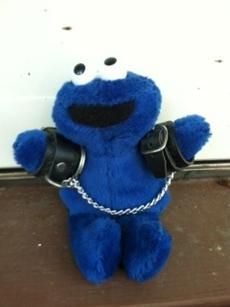Cookie Monster and the Serial Killer
Cookie Monster and the Serial Killer:
A killer’s strange insanity defense involved the beloved puppet
Harrison “Marty” Graham was evicted from his apartment on a sweltering August day in 1987, due to obnoxious odors. Inside, the police found the remains of seven women. Graham, 28, first stated that the bodies had been there when he moved in, but then he confessed to having strangled them all … accidentally.
The first officer to arrive bent down to a keyhole and saw a black woman’s naked legs. He knocked and announced himself. With an investigator from the Medical Examiner’s Office, he forced the door and entered the fetid room.
The nude female, on a mattress, was deceased. She’d been dead for some time. Next to mattress, on a pile of trash, was another female corpse.
A homicide detective joined the search team. Around 3:45 PM, they turned up a third set of remains, wrapped in two sheets and buried under the debris beneath the second body. These were nearly skeletal, but had shreds of clothing. Less than two hours later, the searchers turned up a fourth set of mummified remains inside some sheets.
The fifth body was found around 5:30, pulled out of another area of debris, but the peculiar detail about this one was that he or she (they couldn’t tell) had been sandwiched between two mattresses. The searchers wondered if the evicted tenant had actually slept on the top mattress with the victim underneath, like a dried flower smashed between pages of a book.
It appeared as though the tenant had resided in one room and had kept the adjoining room as his own private mausoleum. Another two hours went by before a sixth body was located crammed inside a tiny six-inch deep closet, sitting up, wrapped in a sheet and tied with white electrical cord. Another decomposed body was found outside the window, on the roof.
The search was on for the evicted tenant. When he left, Graham had taken a water bottle, some items of clothing and his raggedy blue Cookie Monster.
Investigators learned that Graham was known to take long walks and play basketball with local kids. He liked to entertain them with his Cookie Monster. Other neighbors said he was a loner, but when he got drunk he’d act a “little crazy.” He talked to his puppet all the time.
Graham was arrested on the streets. He finally confessed to killing the women found in his apartment, but was hazy on the details. He’d accidentally killed them during sex, he admitted, under the influence of drugs. He was full of remorse.
Eventually, he went to trial. Among the seized evidence was his Cookie Monster puppet, which he asked to have back. “I sleep with that,” he said. But the puppet remained in evidence.
Defense attorney Joel Moldovsky had prepared well for his client: it wasn’t just insanity, he said, these acts had been due to Graham’s multiple personality disorder. Harrison Frank Graham, Jr. was presented as having three distinct personalities. “Frank” was a foul-mouthed drug addict and murderer; “Junior” was an unmanageable two-year-old who adored the Cookie Monster, and “Marty” was the likeable handyman who had complied with the police.
Graham chose to have the judge decide his case. Apparently his attorney and his mother had convinced him that the graphic evidence would strongly offend a jury.
The prosecutor offered some powerful witnesses. Two women said they’d lived with Graham and survived, but just barely. One testified that during sex he would place his hands around her throat and squeeze. Several times she’d thought he was killing her. He’d told her, she said, that he’d killed one of his former girlfriends in anger.
The second witness confirmed that Graham had confessed to this killing. He’d also threatened her with a machete.
Moldovsky asked this witness to pull the crusty Cookie Monster puppet out of a bag of items. She did not want to touch it, but she did admit that he’d chatted with it every day that she’d lived with him
A psychiatrist for the defense said that since Graham had said he could not recall the first five murders, it was not possible to judge his mental state at the time of those crimes. However, during the last two incidents, he’d hallucinated the voices of both God and the devil. Thus, he had been psychotic.
Nevertheless, the judge found Graham guilty on all counts of first-degree murder and abuse of a corpse. Graham just blinked and shook his head. Moldovsky later told reporters, “I assume he knows he was found guilty, but I’m not sure.” Graham asked to have his Cookie Monster back.
The sentences were a mix of both life without parole and death. In an unusual move, the judge decided that Graham should not to be executed until after he’d served the life sentence. Moldovsky found this ruling to be “Solomonic” and compassionate. It meant that Graham had received a life sentence without the possibility of parole.
However, his sentence went through a round of unusual challenges until the death sentences were vacated in 2003, due to his low IQ and indicators of early-onset mental illness. He was considered not competent to be executed.
Behind bars, he became an ordained minister.
Dr. Katherine Ramsland is a professor of forensic psychology at DeSales University in Pennsylvania, where she also teaches criminal justice. She holds a master’s in forensic psychology from the John Jay College of Criminal Justice, a master’s in clinical psychology from Duquesne University, a master’s in criminal justice from DeSales University, and a Ph.D. in philosophy from Rutgers. She has been a therapist and a consultant. Dr. Ramsland has published over 1,000 articles and 46 books, including:
Snap! Seizing Your Aha Moments
Paranormal Forensics
The Mind of Murder a Murderer: Privileged Access to the Demons that Drive Extreme Violence
Inside the Minds of Serial Killers
The Forensic Psychology of Criminal Minds
The Forensic Science of CSI
The Criminal Mind: A Writer’s Guide to Forensic Psychology
True Stories of CSI
Beating the Devil’s Game: A History of Forensic Science and Criminal Investigation
Inside the Minds of Healthcare Serial Killers
Inside the Minds of Mass Murderers
The Human Predator: A Historical Chronology of Serial Murder and Forensic Investigation
Psychopath
The Vampire Trap
The Ivy-League Killer
Piercing the Darkness: Undercover with Vampires in America Today
Dr. Ramsland’s background in forensics positioned her to assist former FBI profiler John Douglas on his book, The Cases that Haunt Us, to co-write a book with former FBI profiler, Gregg McCrary, The Unknown Darkness, to collaborate on A Voice for the Dead with attorney James E. Starrs on his exhumation projects, and to co-write a forensic textbook with renowned criminalist Henry C. Lee, The Real World of a Forensic Scientist.
For seven years, she contributed regularly to Court TV’s Crime Library, and now writes a column on investigative forensics for The Forensic Examiner and a column on character psychology for Sisters in Crime; offers trainings for law enforcement and attorneys; and speaks internationally about forensic psychology, forensic science, and serial murder. She has appeared on numerous cable network documentaries, as well as such programs as The Today Show, 20/20, Montel Williams, NPR, Larry King Live and E! True Hollywood. For ID, she spoke as a recurring expert on the series, American Occult and Wicked Attractions.






I’ll never look at the Cookie Monster the same way ever again… But I’m puzzled; how would one execute someone AFTER they’ve served a life sentence?